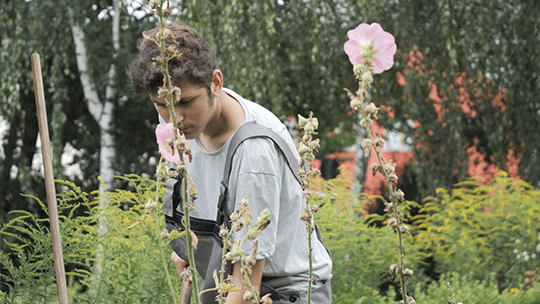Home / / Photo / Sculptures / Curatorial Projects / Bio / Contact
![]()

![]()

![]()

![]()
> stills and quotes
![]() > installation views
> installation views
![]()
![]()
AN OCTOPUS DESTROYED THE MOON
90 min film, 2024 & three channel video installation, 2023
Horticulture, agriculture and animal care are taught in the agricultural department of the integrative August Sander School in Berlin Friedrichshain. Over the course of a school year, the film accompanies students with different learning capacities, behavioral issues and impairments in their everyday school life. A portray of adolescents at the crossroads between school and work, childhood and adulthood, struggling to find their place in the school system and society.
The pupils in this vocational school are supposed to learn social skills, teamwork, discipline and a sense of responsibility in theory and practice. Different learning skills, special educational needs and difficult social circumstances are daily challenges. Boundaries are constantly tested, authority is challenged. Emotions, aggression, frustration, various conflicts and cultural differences must be dealt with. Integration is practiced on a daily basis, friendships and love relationships are formed.
How do you fit into a 'system' from which you fell out? The young people are repeatedly reminded that presence, perseverance and performance are required not only in school but in their future working life.
'An Octopus Destroyed the Moon' observes the students in the classroom and the school garden while planting and harvesting vegetables, feeding animals, or digging over the manure heap. Working in the garden is physically demanding, but also allows new experiences of time and nature – of growth cycles and decay – and to reflect on one's own life, on family, friendship, cultural backgrounds, hopes and fears. Their personalities and views of the world are further revealed during theoretical classes such as botanics, economics and social studies, or math.
In personal conversations with the class teachers the students are assessed, and strategies for dealing with their strengths and weaknesses, future career goals and prospects are discussed. In role-playing games, during class council and breaks, different temperaments and character traits are further revealed. There are laughter, teasing, bickering and sometimes nasty comments that lead to tears.
Talking boldly about their abilities, fears and weaknesses, their hopes and dreams, the film also becomes a stage for their self-expression and self-empowerment.
The teachers, the school garden, the plants, the school animals such as sheep, goats, rabbits and bees, and the rapidly changing urban space around the school are further protagonists of the film. The school garden not only symbolizes the cycle of nature, but also the integration of the individuum into the community, the importance of care and mindfulness in dealing with each other and nature.
How do we want to live? How do we participate in our society?
In the search for our place in society, school and work play a central role in our development as individuals in society. How can young people who find it difficult to fit in due to impairments, difficult childhood experiences or family circumstances 'function' in the school system and open up a space for personal freedom of expression and development?
What happens in a social structure within a community that is not freely chosen, such as school, over the course of a school year? How do individual personalities develop within the group and in relation to each other, especially during the complex time of puberty?
'An Octopus Destroyed the Moon' explores the fragile relationships between humans, agriculture and nature, and shows through the young people's individual stories the importance of social learning, education, work, career and participation in our society.
with: Anna Kania, Blenda B., Chantalle Oestreich, Cosma Roszkiewicz, Jessica Michutta, Mario Faber, Mohammed El-Dghaili, Muhammed Ali Kahveci, Salome Agyemang, Soner Horoz, Tom Behrens, Travis Loichen, Vincent Tiz; Anja Michalik, Antje Nagel, Berit Kastner, Frank Dietrich, Kerstin Richter, Martin Wenzel, Micha Ziegler, Sylvia Weber, Urte Gladigau, Margarita Feigenbaum
concept, camera, editing: Heidrun Holzfeind
Advise on editing and dramaturgy: Bettina Blickwede
image post & color grading: Martin Ebner
sound post & mix: Sebastian Kleinloh
graphics: Karin Holzfeind
English translations (subtitles): Luzie Meyer, Jonathan Quinn, Claudia Steinberg, Isabelle Dupuis
subtitling: Celine Jünger
Thank you:
den Schüler*innen und Lehrkräften der NU2, dem Team
und der Schulleitung der August-Sander-Schule Berlin,
Markus Gleisser, Bettina Blickwede, Katie McQuerrey,
Isabelle Dupuis, Stefanie Gaus, Jo Schmeiser, Annette
Weisser, Karin Holzfeind, Katharina Copony, Jakob
Holzfeind, Christoph Draeger
![]()
-